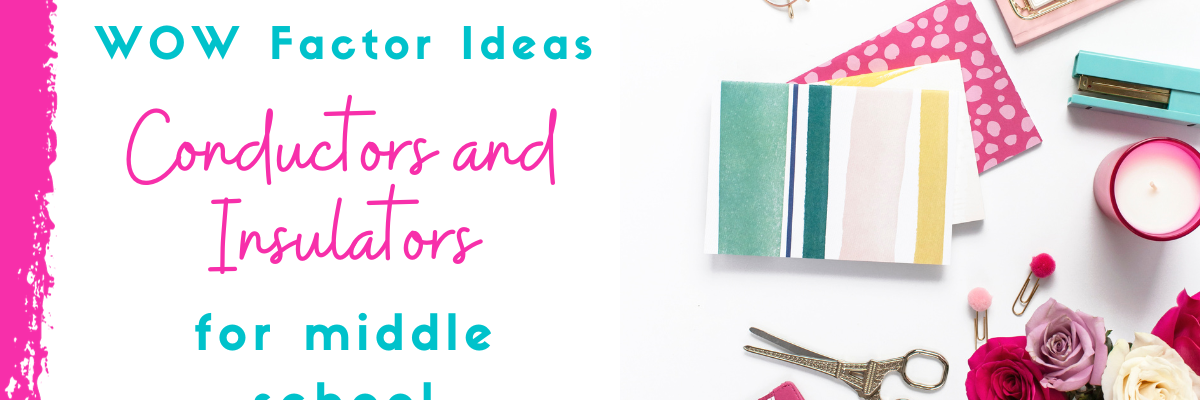Thermal and electrical conductors and insulators are used in our everyday life. They take part in the functionality of electrical systems, appliances, and many kinds of everyday items.
Teaching your students about these is essential in understanding why certain things are created as they are, such as electrical wires, and who knows, your students could invent something of their own in the future with this knowledge.
Time to bring the WOW Factor! In this post, I share how you can get your students excited about learning more about thermal and electrical conductors and insulators. Second, I share an interactive lesson that will dive deeper into helping your students understand conductors and insulators and their relationship with thermal energy and electrical energy. Finally, I will share some WIDEN strategies that will help your students apply their new knowledge and expand it!

Conductors and Insulators WONDER Strategies
WONDER strategies are those introductory activities that you do to hype your students, helping them to become internally motivated to learn! Here are two different WONDER strategies that you can try to gain student buy-in when you teach this topic!
Item Sort
Give your students a chance to organize some items in the way in which they think they should go.
- Gather some everyday materials that are conductors and insulators. Here are some examples. Some conductors would be a metal spoon, copper wire, aluminum foil, metal keys, pennies, and paper clips. Some insulators would be plastic spoons, cotton fabric, paper, cardboard, plastic rulers, rubber gloves, and a marble.
- Split your students into groups and give them these items. If you don’t have enough materials for groups, you can do this as a class or you can just print off pictures of them for each group.
- Tell your students to sort them. Don’t tell them how, but just see what they come up with.
- After each group sorts their objects. Have students walk around to other groups to see how each group sorted them. You can also just discuss it.
- Tell your students that these can be sorted into conductors and insulators! Tell them that they are about to learn why!
Makey Makey
Another activity that you can do is to let your students explore a Makey Makey. Don’t have time or the materials? You can always let them watch this video.
A Makey Makey is an invention kit that allows you to take everyday objects and turn them into keyboards/touchpads. It uses electrical conductivity. You complete a circuit using an object that conducts electricity! It needs to have a conductive path for electrical current to flow!
Not just any item will work. Experimenting with different items is what makes this so much fun!
Learn more about Makey Makey here!
Conductors and Insulators Interactive Lesson
Interactive lessons are fabulous in teaching students the content without them being overwhelmed. Sometime, science content can be heavy with critical thinking and vocabulary. However, interactive lessons incorporate the 7 steps to help students retain information. With these strategies, the lesson helps to reduce student cognitive load and helps them to commit information to their long-term memory!
In this conductors and insulators interactive lesson, students will learn about thermal energy and electrical energy and their relationship to materials that are conductors and insulators. They will learn about conductors an insulators, examples of them, and about real-world applications.

Inside of the lesson, there are embedded questions to help students process the material that they are learning. These include a KWL, drag-and-drop questions, brainstorming an experiment, a Venn diagram, and more!
Students love these!
This lesson can be found in the Bright in the Middle Shop.
It can also be found on TPT!
Thermal and Electrical Conductors and Insulators WIDEN Activities
As with any good lesson, it’s always good to explore and expand. That’s what WIDEN activities do! Here are two different activities you can try in your classroom!
Electrical Conductor or Insulator Test
In this activity, students can build an electrical conductivity test!
You’ll need:
- Batteries
- Wires with alligator clips or wires that are stripped on the end
- Light bulb
- Various objects (conductors and insulators) for testing!
Your students will need to:
- Set up a simple circuit using the battery, wires, and light bulb. The light bulb should light up!
- Choose different items to add as a connector to see if they are conductive! You can try pennies, plastic forks, tape, wood, cardboard, aluminum foil, rubber bands, etc!
- Make sure students record their observations!
Heat Transfer Paper
You can also do this fun experiment with heat sensitive paper!
Showing is better than telling, so check this out!
Which thermal and electrical conductors and insulators activities are you going to add to your lesson?
Help your students master science content!



[…] Conductors and Insulators […]